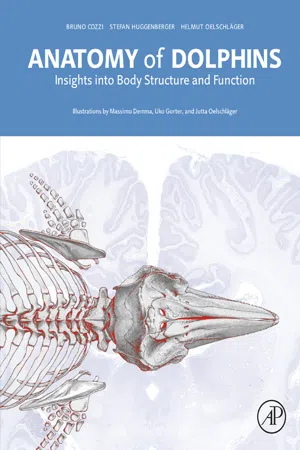
Anatomy of Dolphins
Insights into Body Structure and Function
- 456 pages
- English
- ePUB (mobile friendly)
- Available on iOS & Android
Anatomy of Dolphins
Insights into Body Structure and Function
About this book
The Anatomy of Dolphins: Insights into Body Structure and Function is a precise, detailed, fully illustrated, descriptive, and functionally oriented text on the anatomy and morphology of dolphins. It focuses on a number of delphinid species, with keynotes on important dolphin-like genera, such as the harbor porpoise. It also serves as a useful complement for expanding trends and emphases in molecular biology and genetics.The authors share their life-long expertise on marine mammals in various disciplines. Written as a team rather than being prepared as a collection of separate contributions, the result is a uniform and comprehensive style, giving each of the different topics appropriate space. Many color figures, which use the authors' access to wide collections of unique dolphin and whale material, round out this exceptional offering to the field.- Includes high-quality illustrations, drawings, halftone artwork, photographic documentations, microphotos, and tables detailing dolphin anatomy, function, and morphology- Facilitates education and training of students of all basic research and applied sciences dedicated to marine biology and the medical care of marine mammals- Brings together the current knowledge and information on this topic, including those in obscure past or non-English publications, or scattered in short chapters in volumes- Covers a number of delphinid species and serves as a useful complement for expanding trends in molecular biology and genetics
Frequently asked questions
- Essential is ideal for learners and professionals who enjoy exploring a wide range of subjects. Access the Essential Library with 800,000+ trusted titles and best-sellers across business, personal growth, and the humanities. Includes unlimited reading time and Standard Read Aloud voice.
- Complete: Perfect for advanced learners and researchers needing full, unrestricted access. Unlock 1.4M+ books across hundreds of subjects, including academic and specialized titles. The Complete Plan also includes advanced features like Premium Read Aloud and Research Assistant.
Please note we cannot support devices running on iOS 13 and Android 7 or earlier. Learn more about using the app.
Information
Natural History and Evolution of Dolphins: Short History of Dolphin Anatomy
Abstract
Keywords
Evolutionary Biology of Whales and Dolphins
Odontoceti (toothed whales)
Table of contents
- Cover
- Title page
- Table of Contents
- Copyright
- About the Authors
- About the Illustrators
- Foreword
- Introduction
- Chapter 1: Natural History and Evolution of Dolphins: Short History of Dolphin Anatomy
- Chapter 2: General Appearance and Hydrodynamics (Including Skin Anatomy)
- Chapter 3: Locomotion (Including Osteology and Myology)
- Chapter 4: Diving: Breathing, Respiration, and the Circulatory System
- Chapter 5: Head and Senses
- Chapter 6: Brain, Spinal Cord, and Cranial Nerves
- Chapter 7: Body Control: The Endocrine System and the Peripheral Nervous System
- Chapter 8: Feeding and the Digestive System
- Chapter 9: Urinary System, Genital Systems, and Reproduction
- Chapter 10: Neurobiology and the Evolution of Dolphins
- Index